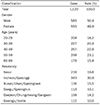1. Guideline of functionality evaluation for health functional food - ‘help to maintain healthy bowel function’. Cheongju: National Institute of Food and Drug Safety Evaluation;2015.
2. Bourlioux P, Koletzko B, Guarner F, Braesco V. The intestine and its microflora are partners for the protection of the host: report on the Danone symposium “the intelligent intestine,” held in Paris, June 14, 2002. Am J Clin Nutr. 2003; 78:675–683.

3. Song KH, Jung HK, Min BH, et al. Development and validation of the Korean Rome III questionnaire for diagnosis of functional gastrointestinal disorders. J Neurogastroenterol Motil. 2013; 19:509–515.
4. Drossman DA. ROME IV functional gastrointestinal disorders: disorders of gut-brain interaction. 4th edition. Raleigh: Rome Foundation, Inc.;2017.
5. Francis CY, Morris J, Whorwell PJ. The irritable bowel severity scoring system: a simple method of monitoring irritable bowel syndrome and its progress. Aliment Pharmacol Ther. 1997; 11:395–402.
6. Boyce P, Gilchrist J, Talley NJ, Rose D. Cognitive-behaviour therapy as a treatment for irritable bowel syndrome: a pilot study. Aust N Z J Psychiatry. 2000; 34:300–309.

7. Patrick DL, Drossman DA, Frederick IO, DiCesare J, Puder KL. Quality of life in persons with irritable bowel syndrome: development and validation of a new measure. Dig Dis Sci. 1998; 43:400–411.
8. Groll D, Vanner SJ, Depew WT, et al. The IBS-36: a new quality of life measure for irritable bowel syndrome. Am J Gastroenterol. 2002; 97:962–971.

10. Churchill GA Jr. A paradigm for developing better measures of marketing constructs. J Mark Res. 1979; 16:64–73.
11. DeVellis RF. Applied social research methods series, Vol. 26. Scale development: theory and applications. Thousand Oaks: Sage Publications Inc.;1991.
12. Lawshe CH. A quantitative approach to content validity. Pers Psychol. 1975; 28:563–575.
13. Veldhuyzen van Zanten SJ, Chiba N, Armstrong D, et al. Validation of a 7-point global overall symptom scale to measure the severity of dyspepsia symptoms in clinical trials. Aliment Pharmacol Ther. 2006; 23:521–529.

14. Hensley RL. A review of operations management studies using scale development techniques. J Oper Manage. 1999; 17:343–358.
15. Woo JP. The concept and understanding of structural equation modeling with AMOS 4.0–20.0. Seoul: Hannarae Publishing Co.;2012.
16. Connell AM, Hilton C, Irvine G, Lennard-Jones JE, Misiewicz JJ. Variation of bowel habit in two population samples. Br Med J. 1965; 2:1095–1099.

17. Drossman DA, Sandler RS, McKee DC, Lovitz AJ. Bowel patterns among subjects not seeking health care. Use of a questionnaire to identify a population with bowel dysfunction. Gastroenterology. 1982; 83:529–534.
18. Heaton KW, Radvan J, Cripps H, Mountford RA, Braddon FE, Hughes AO. Defecation frequency and timing, and stool form in the general population: a prospective study. Gut. 1992; 33:818–824.

19. Talley NJ, Weaver AL, Zinsmeister AR, Melton LJ 3rd. Onset and disappearance of gastrointestinal symptoms and functional gastrointestinal disorders. Am J Epidemiol. 1992; 136:165–177.

20. Harari D, Gurwitz JH, Avorn J, Bohn R, Minaker KL. Bowel habit in relation to age and gender. findings from the national health interview survey and clinical implications. Arch Intern Med. 1996; 156:315–320.

21. Jeon SG, Sohn CI, Kim JE, et al. Bowel habits in routine check-up subjects. Korean J Med. 1999; 57:36–41.
22. Jun DW, Park HY, Lee OY, et al. A Population-based study on bowel habits in a Korean community: prevalence of functional constipation and self-reported constipation. Dig Dis Sci. 2006; 51:1471–1477.







 PDF
PDF ePub
ePub Citation
Citation Print
Print











 XML Download
XML Download